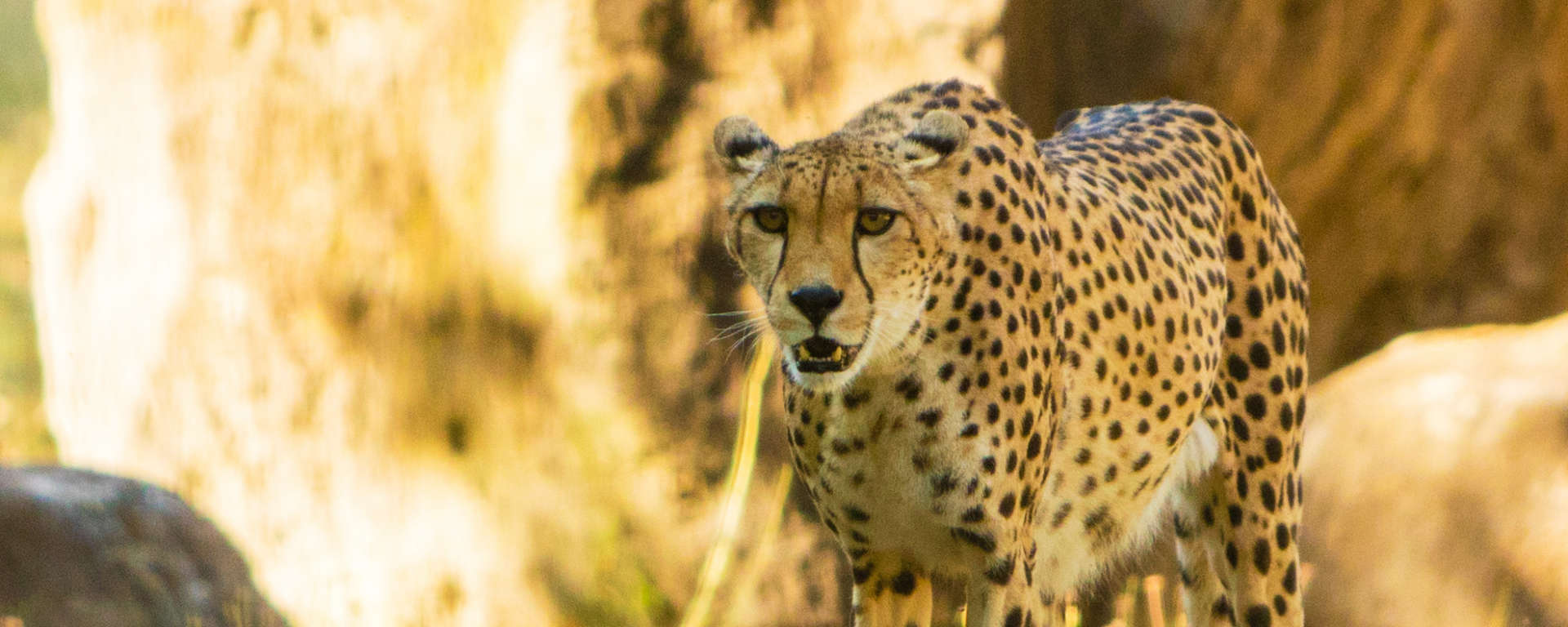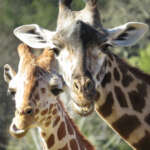Happy International Cheetah Day!
Posted in: Conservation, Safari Spotlight
A Special Day for a Speedy Creature
On December 4th, please join Safari West in celebrating the 7th annual International Cheetah Day. We, and our fellow AZA institutions, celebrate this annual event to bring attention to a truly unique animal. Famous for its blistering speed, the cheetah (Acinonyx jubatus) is also Africa’s most endangered large cat. Once upon a time, nearly 100,000 cheetahs stalked their prey across much of Africa as well as into the Middle East and India. These days fewer than 7,000 remain, scattered across some 29 geographically isolated populations.
Fierce and Phenomenal
The remaining cheetahs are no less spectacular for their scarcity. Though nowhere near as large as lions or tigers, cheetahs still present an impressive silhouette. Most tip the scales at somewhere between 100 to 120 pounds once they’ve reached their adult weight, and they stand taller than many large-breed dogs. Like their large African cousin—the leopard—cheetahs have fur spattered with black spots. What makes them easy to identify however, are their long, lean bodies, small heads, and impressively long legs.
These features grant cheetahs their most famous, and impressive ability: the cheetah sprint. Well known as the fastest runners on the planet, a cheetah on the hunt can reach speeds of up to 60 miles per hour or more. Though they cannot maintain this heart-pounding pace for long, at such speeds, long chases are rarely necessary.
The Struggle for Survival
With such an impressive resume, how is it that cheetahs find themselves struggling for survival in our modern world? Several factors explain the unfortunate situation, some naturally occurring and others man-made. For one, cheetahs face stiff competition on the African plain. Solo hunters, they must often defend their prizes from groups of lions or hyenas. Outsized and outnumbered, cheetahs lose a surprising amount of hard won food in these conflicts. One way to combat this problem comes from hunting during the day, when most other predators sleep. Among the famously nocturnal cats, the diurnal cheetah is quite the oddity.
Another problem cheetahs face appears at the genetic level. Some 12,000 years ago, cheetahs experienced a population bottleneck. For reasons not well understood, the species declined and nearly went extinct. Though they survived this ancestral struggle, the small number of surviving animals resulted in a lack of genetic diversity in today’s population. One problem that results from such long-term inbreeding comes in the form of high infant mortality.
Mankind and the Modern World
Of course, lions, hyenas, and low genetic diversity are old problems and some that cheetahs have been contending with for millennia. Mankind presents a newer challenge. Though our species and that of the cheetah have also coexisted for many thousands of years, our relationship is one in constant flux. The advent of modern industry, urban sprawl, and the unprecedented human population explosion have converged to make life very tough for today’s cheetah.
In general terms, cheetahs in Africa experience many of the same trouble as wolves in America. Both predatory species travel widely and can cross any number of boundary lines, both physical and political. Both species struggle with the need to navigate roadways and the dangerous vehicles traveling upon them. Most critically of all, both species will substitute domesticated prey for their more typical wild targets when their land becomes cultivated.
Just as happens here in America, shepherds and ranchers in Africa tend not to look kindly on cheetahs consuming their livestock. Trappings, poisoning, and the shooting of cheetahs as pest animals is unfortunately far too common.
Education and Outreach to the Rescue
The two largest populations for cheetahs can be found in the South African nations of Namibia and Botswana respectively. Luckily, both countries are home to amazing conservation organizations working to address these issues. Both the Cheetah Conservation Fund in Namibia, and Cheetah Conservation Botswana have ongoing relationships with Safari West. Some key features focused on by both organizations are habitat restoration and human-cheetah conflict resolution.
An amazingly useful practice promoted by both agencies is to provide livestock guarding dogs to local farmers and ranchers. These dogs do the same job in Africa that they do throughout much of the westernized world. Their presence among a flock of sheep or goats goes a long way toward deterring predation by cheetahs. Without this conflict, the farmers have no reason to go after the cheetahs.
The Fight Goes on
Promising though this work is, we’re still a long ways from declaring victory in the fight to protect cheetahs. On this International Cheetah Day, please consider joining the fight on the side of survival. Study up on cheetahs and what makes them so special and, if you’re able, consider making a donation to one of the organizations working to protect them. We fully endorse both the organizations mentioned above and if you don’t want to have to choose between them, consider a donation to the Safari West Wildlife Foundation instead. The foundation not only supports both agencies, but also utilizes such donations to continue to refine our own education and conservation programming right here in Sonoma County.
Happy International Cheetah Day everybody!


